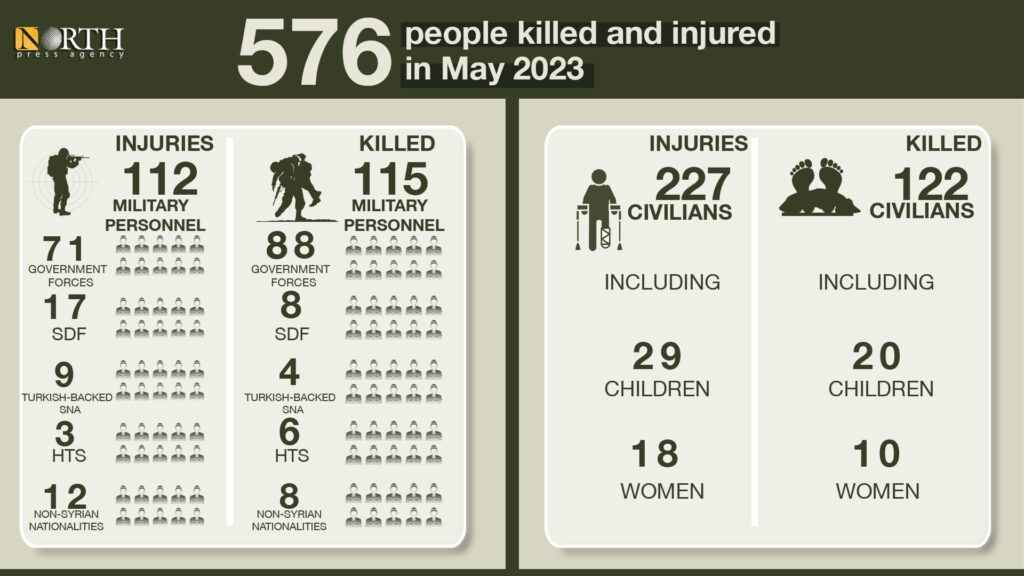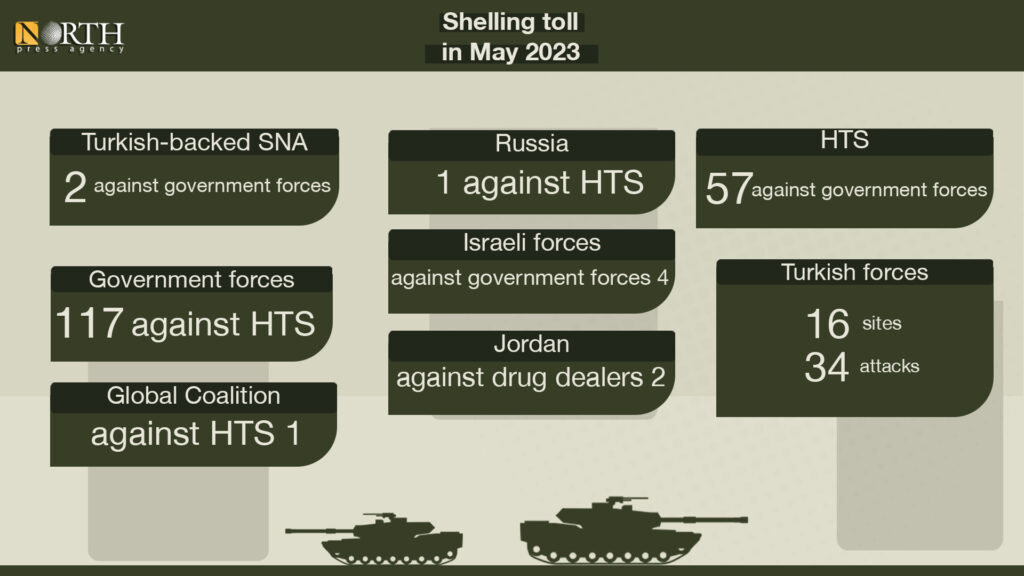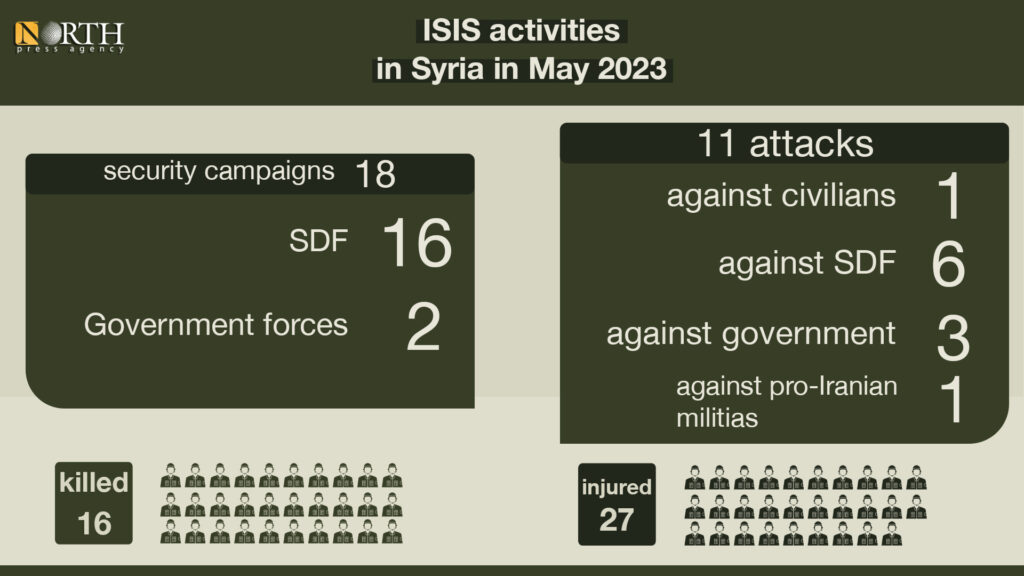Introduction
In May, based on data recorded and analyzed by the Monitoring and Documentation Department of North Press, Syria witnessed a 20 percent decline in insecurity and conflict events since April. Human rights violations against civilians decreased by about 32 percent. Islamic State (ISIS) activity decreased by 63 percent.
The Monitoring and Documentation Department, in its monthly report, addresses the most prominent human rights violations documented in the month of May, based on information the department obtained from a network of field sources in different parts of Syria.
The report reveals the outcome of human rights violations, including killings and arbitrary arrests by all parties, as well as statistics on the number of people who lost their lives due to war remnants, which some parties plant on the outskirts of their areas of control in order to protect themselves from attacks.
The report also addresses the indiscriminate shelling by conflicting parties and its repercussions and the damages caused to civilians and public property. It also touches upon ISIS activities, the long-term crises that continue to deteriorate, and other issues that affected Syrians and destabilized security and stability during May.
Victims
The number of victims of human rights violations in Syria decreased by about 32 percent from April to May.
The victim toll recorded by the department in the last month amounted to 576 civilians and military personnel, of whom 237 lost their lives, and 339 were injured due to direct attacks, indiscriminate shelling, or as a result of incidents of torture, violence or other forms of inhumane treatment.
All civilians were killed by extrajudicial means at the hands of either the conflicting parties or unknown gunmen.
The number of civilian casualties reached 349, of whom 122 were killed, including 20 children and 10 women, and 227 others were wounded, including 29 children and 18 women.
The civilian victims were recorded in several Syrian governorates, with Homs, in central Syria, topping the list at 65 victims, followed by Deir ez-Zor with 55, then Daraa with 47, and Aleppo with 30.

As for the military casualties of the four conflicting forces in Syria, 115 were killed, and 112 others were wounded, including 88 dead and 71 injured within the ranks of the Syrian government forces.
Four deaths and nine injuries were recorded among militants of the Turkish-backed opposition factions, also known as the Syrian National Army (SNA). As for militants of Hayat Tahrir al-Sham (HTS, formerly al-Nusra Front), six deaths and three injuries were recorded in addition to the deaths of eight and the wounding of 12 individuals of non-Syrian nationalities.
Meanwhile, one person from a local group was killed, eight fighters of the Syrian Democratic Forces (SDF) were killed, and 17 others were wounded.
The number of victims of war remnants has decreased by about 71 percent compared to last month. Unexploded ordinances claimed 42 victims, of whom three children, six men, and six military personnel were killed, as well as nine children, one woman, four men, and 13 military personnel were wounded.
As for bombardment, de-escalation zones across the country witnessed a military escalation through shelling and continuous clashes between government forces, HTS, and SNA factions.
65 positions in government-held areas were attacked, where HTS carried out 57 strikes; Israel carried out four strikes; Jordan carried out two strikes; and SNA factions conducted two strikes. During these attacks, 49 individuals were killed, and 40 were wounded.

119 positions in HTS-held areas were shelled, 117 strikes were conducted by government forces, one by Russia, and one by the US-led Global Coalition. Five individuals were killed in these attacks, and seven were injured.
Turkish authorities are still attacking northeast Syria. During May, they attacked 16 positions in northeast Syria, with 34 strikes that caused the deaths of 12 people, including one woman and five members of government forces and three SDF fighters, in additions to the injury of 10 others, including one child and two members of government forces and civilians.
Arrests and enforced disappearances remain one of the most prominent issues of Syria’s 12-year-long war. In May, 265 people were arrested across Syria, mostly arbitrarily, by all parties to the conflict.
HTS arrested 131 people, including five women and two media activists. Most of the detainees were opposed to HTS.
SNA factions arrested 56 people, including seven women and three children. Nine of the detainees are from Sere Kaniye (Ras al-Ain), and the rest were arrested in the northern countryside of Aleppo on charges of previous collaboration with the Autonomous Administration or false accusations.
The Syrian government arrested 36 people, including four women and a child, mostly for unknown reasons. In areas held by the Autonomous Administration of North and East Syria (AANES), 39 people were arrested, most of them on charges of belonging to ISIS.
The Lebanese Hezbollah arrested a man and a woman on charges of poisoning its members. A local faction in Suwayda Governorate arrested the head of the city’s Traffic Division.
ISIS activities
Compared to April, ISIS activity in May recorded a 63 percent decline, with 11 attacks, of which ISIS only claimed responsibility for seven attacks. The group carried out six attacks against the SDF, three against government forces, one against Iranian-backed militias, and one against civilians.
ISIS attacks were recorded in different places: four in Deir ez-Zor, two in Hasakah, two in Raqqa, two in Homs, and one in Damascus.
The number of victims of ISIS attacks across Syria reached 43, of whom 16 died and 27 were wounded, either in direct attacks or landmine explosions.
In detail, the number of victims of ISIS attacks reached 27, of whom 11 were killed, and 16 were injured. Remnants of war planted by ISIS killed five people and wounded 11 others.
As a result of ISIS attacks, a civilian was killed, and another was wounded. The military victims resulting from the ISIS attacks included six dead and three wounded from government forces, as well as nine SDF soldiers wounded, while two Iranian-backed militiamen were also killed.
18 security campaigns were launched against ISIS. The SDF launched 16, seven of which were conducted with the US-led Global Coalition, including two airdrops, in which an ISIS suspect was killed, another was wounded, and 30 others were arrested. The government forces carried out two security campaigns and killed three individuals accused of belonging to ISIS.

Violations of SNA and Turkish army in Syria
In May, the Turkish-backed SNA killed five people, including a woman, and injured 25 others, including three children and five women. They carried out two cases of appropriation of civilian property in Afrin and four cases of theft, as well as 10 cases of imposing royalties on people living in areas under their control, mostly on land and olive press owners.
In addition, SNA factions continue their cultural and environmental violations in Afrin by logging trees and excavating archeological sites. The Documentation Department recorded the logging of 1,497 fruit and forest trees, most of them in Afrin. SNA factions bulldozed large mountainous areas near the village of Iskan in southern Afrin in preparation for the establishment of new settlements.
The Turkish army keeps violating human rights and international humanitarian law in Syria through indiscriminate shelling against regions of northeast Syria and direct targeting of asylum seekers. The Turkish army killed one person and injured another by sniper fire from the direction of a Turkish base in Manbij region.
Turkish authorities, in cooperation with SNA factions in Sere Kaniye, using two vehicles of the Turkish Intelligence, transported four detainees from the prison of the military police in the city to one of their prisons in Şanlıurfa under charges of threatening Turkish national security. The transfer is a violation of International Humanitarian Law and the European Convention on Human Rights, which state that the transfer of detainees from one state to another where they may be subjected to torture or inhuman or degrading treatment is prohibited.
Turkish border guards continue to commit violations against asylum seekers who try to cross the Syrian-Turkish border. They directly attacked and injured 10 people, including three women and a child, and beat 26 people, including five children and five women. They also detained 19 people while trying to cross the border.
The ongoing violations by parties to the conflict put Syrian lives in danger. The Syrians’ human rights are universal and must not be violated or neglected, and the perpetrators should not be allowed impunity.
All parties must therefore abide by United Nations resolutions and International Humanitarian Law and act immediately to protect the civilian population. The international community and the parties concerned must make every possible effort to end the conflict in Syria and stop violations that deprive Syrians of their rights.
Humanitarian Situation
The people of Syria suffer from the deteriorating humanitarian situation due to the exacerbation of the economic, health, political, and military crises directly impacting their right to live a safe and dignified life, as well as creating a gap between them and their rights to shelter, food, health care, social justice, and economic stability, which is worsening by the year.
The economic crisis is at the top of the crises in Syria. The rapid deterioration is due to the strict US and EU sanctions imposed on the Syrian government and the constant decline of the Syrian pound’s value against the US dollar. Last month, the exchange rate of one US dollar on the black market reached about 9,100 SYP. On May 2, the Central Bank of Syria raised the official exchange rate of the US dollar to more than 8,000 SYP.
The continuous economic decline has led to high prices of food, fuel, public and health services, and real estate across the country, but particularly in government-held areas, due to the low income and prohibition against trading with the US dollar.
IDPs in camps are the most affected by the health and economic crisis. About 6,9 million Syrians are still struggling to secure their basic needs, and live in camps in inhumane conditions. They lack the most basic essentials of life. North Press interviewed 12 individuals from al-Rukban and the new Eastern Manbij camps and makeshift camps in Raqqa and Deir ez-Zor.
Al-Rukban camp, which is considered one of the worst Syrian IDP camps, is located on the Syrian-Jordanian border in a remote area. The IDPs cannot enter Jordan or Syria, and they receive no assistance. The people in the camp experience poor living and health conditions and lack of security.
In camps in northeast Syria, the majority of the IDPs complain about the lack of relief and health assistance, worn-out tents, absence of an infrastructure compatible with health requirements hence providing an environment that helps the spread of diseases and pandemics such as cholera and leishmaniasis. According to Save the Children, an NGO, there are thousands of children who suffer from malnutrition in camps.
On May 17, Save the Children issued a report suggesting that the levels of child stunting in Syria may reach unprecedented levels and that one out of eight pregnant women suffer from acute malnutrition. It also stated in its report that the earthquake that struck both Turkey and Syria pushed at least another 665,000 Syrians into hunger. The World Food Programme (WFP) also identified Syria as one of the most hungry and concerning areas on the planet.
On May 11, the administration of Semalka-Faysh Khabur border crossing in the Kurdistan Region of Iraq (KRI) closed the crossing for unknown reasons. This border crossing is the only entrance for international organizations operating in areas held by AANES. In addition, food, vegetables, technical and service supplies, construction materials, and other materials are shipped through the crossing. The closure significantly impacted the prices of goods, food, as well as construction materials and caused a recession in the commercial sector in northeast Syria.
International and regional actions on Syria
In May, several political and human right reports, statements and resolutions were issued regarding Syria. Several United Nations and international meetings and changes in attitudes and decisions have also taken place concerning Syria.
After 12 years of war in Syria, the suspension of its membership by the Arab League in 2011, political and economic sanctions against Syrian government for violent oppression of anti-government protestors, the Syrian government received an invitation to attend an extraordinary meeting of the Arab League on May 7. The decision of Syria’s return to the Arab League was rejected by some countries who refuse normalization with Syria, and demand finding a political resolution and implementation of the UN Resolution 2254.
There are approximately 4,000 foreign ISIS families from 60 different nationalities being held in Syria. Despite repeated appeals of the AANES and human rights organizations that call on states to take back their nationals, the response has been slow and only women and children are being repatriated. In May, New Zealand, Tajikistan, and Kazakhstan repatriated a total of 85 children and 29 women stranded in Hawl camp.
On May 8, the White House announced the continuation of the national emergency with respect to the actions of the government of Syria for another year. In the statement, the US noted that US President “took these actions to deal with the unusual and extraordinary threat to the national security, foreign policy, and economy of the United States constituted by the actions of the Government of Syria in supporting terrorism.” He also noted that the actions of the Syrian government “not only endangers the Syrian people themselves, but also generates instability throughout the region.”
On May 2, the US imposed sanctions on two individuals linked to the financing of two Syria-based groups already sanctioned by the United States and the United Nations. The US Treasury Department said in a statement that “These actions target the leader of HTS, Omar al-Sheikh, and another person, Kubilay Sari, who receives funds in Turkey from donors for the Katibat al-Tawhid wal-Jihad (KTJ).”
In the same context, on May 26, a US court convicted Imad al-Din Wadi, 64, from San Antonio, on charges of financing al-Nusra Front and buying weapons for foreign fighters. Wadi was also convicted of conspiracy to murder and maim in a foreign country and sentenced to 20 years of imprisonment for supporting a terrorist group and 15 years for buying resources for terrorists.
On May 11, Human Rights Watch and Amnesty International together with a number of other organizations, published a joint statement on the deportation of Syrians from Lebanon.
The statement read, “The Lebanese Armed Forces have recently and summarily deported hundreds of Syrians back to Syria, where they are at risk of persecution or torture. The deportations come amid an alarming surge in anti-refugee rhetoric in Lebanon and other coercive measures intended to pressure refugees to return.

